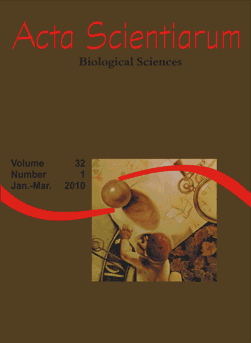<b>The influence of parasitism on the relative condition factor (Kn) of Metynnis lippincottianus (Characidae) from two aquatic environments: the upper Parana river floodplain and Corvo and Guairacá rivers, Brazil</b>- DOI:10.4025/actascibiolsci.v32i1.3668
Keywords:
Ecology, Parasites, Nematode, Digenetic, Hydroelectric plants
Abstract
The study analyzed 84 specimens of Metynnis lippincottianus (Cope, 1870) (Characidae) from two environments with different degrees of impact due to a hydroeletric plant; 44 hosts from the upper Parana river floodplain (low degree of impact) and 40 from Paranapanema tributaries (Corvo and Guairacá rivers, high degree of impact). The prevalence found, among the total collected fishes, was 77.4%. One digenetic species, Dadayus pacupeva, and four nematodes, Spinoxyuris oxydoras, Contracaecum sp. (larval stage), Procamallanus (Spirocamallanus) inopinatus and Raphidascaris (Sprentascaris) mahnerti were identified. In the floodplain, the fishes parasitized by D. pacupeva and S. oxydoras presented better relative condition factor (Kn) than non-parasitized species. Positive correlation between Kn and abundance of these parasites was found in the same area. In the tributaries, the Kn did not differ significantly between parasitized an non-parasitized fishes, not even correlation with abundance of any parasite found.Downloads
Download data is not yet available.
Published
2009-12-02
How to Cite
Moreira, L. H. de A., Yamada, F. H., Ceschini, T. L., Takemoto, R. M., & Pavanelli, G. C. (2009). <b>The influence of parasitism on the relative condition factor (Kn) of Metynnis lippincottianus (Characidae) from two aquatic environments: the upper Parana river floodplain and Corvo and Guairacá rivers, Brazil</b>- DOI:10.4025/actascibiolsci.v32i1.3668. Acta Scientiarum. Biological Sciences, 32(1), 83-86. https://doi.org/10.4025/actascibiolsci.v32i1.3668
Issue
Section
Ecology and Limnology
DECLARATION OF ORIGINALITY AND COPYRIGHTS
I Declare that current article is original and has not been submitted for publication, in part or in whole, to any other national or international journal.
The copyrights belong exclusively to the authors. Published content is licensed under Creative Commons Attribution 4.0 (CC BY 4.0) guidelines, which allows sharing (copy and distribution of the material in any medium or format) and adaptation (remix, transform, and build upon the material) for any purpose, even commercially, under the terms of attribution.
Read this link for further information on how to use CC BY 4.0 properly.
0.6
2019CiteScore
31st percentile
Powered by 

0.6
2019CiteScore
31st percentile
Powered by 











1.png)




3.png)













